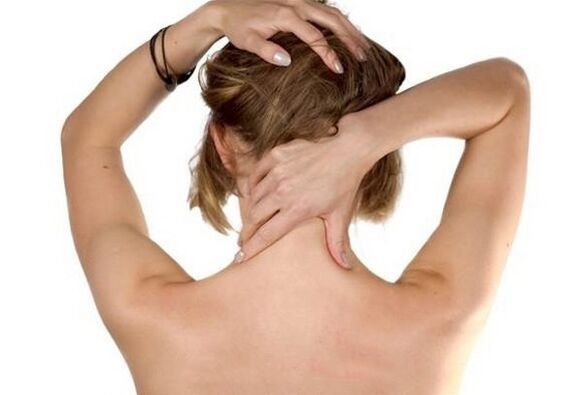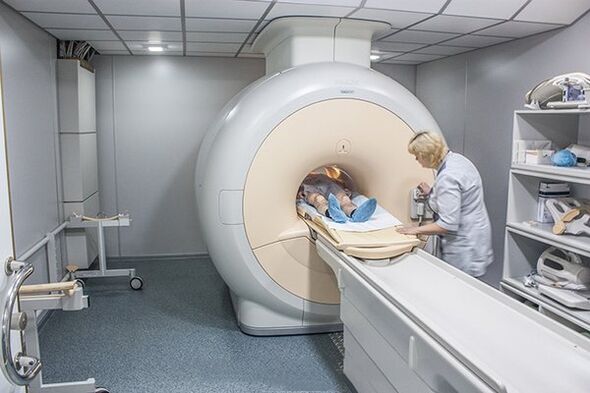
Hello, dear reader.Osteocartilage degeneration is understood as a degenerative disease of the vertebral osteocartilage layer.This question has accepted the global proportions today.In Europe alone, about 60% of adults suffer from cervical osteochondrosis.Doctors associate this fact with people’s static, low mobility and sedentary work.If the disease had developed somewhere at age 50 not long ago, it was impossible to notice that the disease had revived significantly - the average age threshold here has dropped to 24 years old.However, more and more 18-year-olds have solved this problem.When it comes to osteochondrosis in the cervical area, symptoms and treatment cannot be ignored because these problems attract many problems.
How osteochondrosis develops cervical areas - Causes and first signs
Everyone knows that the spine is formed by the vertebrae of the bone, between the "pillows" of that bone - the intervertebral disc.
Due to impaired blood flow and low nutrition, the cartilage tissue here cannot obtain nutrient complexes.
This leads to changes in the cartilage structure, their deformation and contraction.They gradually lose their former elasticity and become less durable.
Because the impact layer that absorbs the intervertebral discs is dry, the vertebrae eat each other.As a result, the nerve ends and the trunk are spread in the blood, which can cause pain and numbness of muscles, migraines and many other symptoms.

As time goes by, the cartilage is destroyed and becomes fiber.Gradually, in this pathological process, adjacent blood vessels, nerve fibers, skeletal structures are involved.
The main factors in the development of cervical bone and cartilage
The fundamental cause of pathological development of osteochondrosis is considered to be changes in degenerative diseases.There are many factors that contribute to this.
Consider the main causes of cervical osteochondrosis.
- Congenital tendency.
- Body aging.
- Crime during metabolism.
- Too much weight and obesity.
- Dietary errors are lack of mineral compounds and systemic lack of liquids.
- Traumatic injury.
- Weak skeletal muscles, incorrect posture, flat feet.
- Hypoemia, a sedentary work.
- Body overload, professional details, make awkward muscles work and more when you have to work in uncomfortable positions.
- The end of the sports career and the termination/reduction of the power load associated with this.
- Psychological and emotional over-technology.
- Toxoprotein dependence.
- The emergence of tumor structure.
It should be pointed out that the causes of cartilage changes in cervical spondylosis have not been fully studied.
However, it is reliable to know that long-term stays in standing or sitting positions without special exercises are overly soft beds, untrained muscles, back and upper limbs, nutrition in lower limbs creates an ideal combination for the development of cervical osteomysia.
The development of disease
Osteochondrosis did not suddenly appear.It gradually develops for a long time - from years to decades.
The initial malnutritional changes in vertebrates cannot be emitted in any way.They can only be found by chance during X-ray pictures or CT.

At the next stage of disease development, a decrease in the thickness of the cartilage layer was observed.Microscopic cracks appear on the vertebrae.A nun with a single muscle may appear.Over time, protrusion will develop and hernia is possible.Patients suffer from head and muscle pain.
In the final stages of disease progression, bone tissue grows pathologically, nerve endings are damaged, and chronic pain occurs.Due to cervical bone cartilage degeneration, curvature of the upper spine, myocarditis, stenosis (stenosis of the spinal lumen) can be observed.
Osteocartilage in the cervical area - Symptoms and treatments
We checked for the first signs of osteochondria and now we will talk directly about the symptoms of cervical osteochondria.
symptom
For cervical osteochondrosis, the following symptoms are characteristics:
- Muscles in the neck, shoulders and upper back are numb and cramped.
- Pulling sensation, dorsal and cervical pain.
- Can give them pain.
- Headache, especially in the occipital lobe area, migraine.
- Dizziness, ears in the ears, visual abnormalities (scattered, the appearance of the "flies" and colorful spots).
- Fingers on the upper limbs are routinely numb.
- The stiffness, rotation and inclination of the head movement are all accompanied by pain and pulling sensation.
- Palpation of mutual areas.
- Trends to increase stress.
Due to muscle weakness, an invasion of motor coordination can be observed.In the presence of heart disease problems, their aggravation may be possible due to spasms of the vertebral arteries.The pain spreads to the sternum and the area where the assembly is held.
As you can see, the symptoms are varied.This leads to the fact that people reveal some of their deviations, turning to the help of this expert (cardiologist, orthopedic doctor, trauma scientist).This complicates the diagnosis and timely detection of cervical osteochondrosis.
Which doctor should you contact
When descriptive symptoms appear that describe osteochondrosis, you should seek medical help without delay.
You need to make an appointment with a therapist or neurologist.According to the investigation, initial clarification of clinical images was performed, and after examination of the patient and palpation of the affected area, the doctor will refer the test and prescribe additional tests.
You may need to:
- X-Thunder.
- Computed tomography.
- MRI.
- Electromyography.
X-rays will determine the location of the lesion and the extent to which the disease is ignored.A tomography study will help evaluate the condition of adjacent tissues, whereas electromyography is the conductivity of muscle fibers and their nerves.

All of this will make it possible to correctly diagnose and outline effective treatment options.This process will be long and requires patience and work for yourself.
It is impossible to fully restore the cartilage structure, but it is a accomplished task to greatly improve the quality of life and get rid of chronic pain.
The exam will be returned more than once.After all, it is necessary to track the course of the disease, adjust the treatment plan, predict possible complications or improvements.
Therefore, even if the pain has subsided, this is not a reason to refuse repeated diagnostic measures.
How to deal with osteochondral disease in the neck
To enable the disease to release the disease, a set of various methods should be used.In most cases, active treatment takes several months.But here depends largely on enthusiasm, the patient's sincerity and his willpower.In some cases, surgical intervention is required.
When starting treatment, it is necessary to follow the following principles.
- Medical advice should be followed steadily.The main doctor should be informed about all changes and adverse reactions in the state.
- It is necessary to learn how to give load doses to avoid excessive muscle activity and excessive muscle muscles.
- It is necessary to give up sports overload, and if necessary, please change the work.
- Medicine and physical education classes are prerequisites.They should be systematically, preferably daily.Considering the possibility of the patient and the degree of neglecting the disease, special gymnastics of the neck should be selected separately.A set of exercises is conducted under the guidance of the instructor.
- The use of anti-inflammatory and analgesics should be reasonable and taken strictly.All medications, especially hormones, are prescribed by a doctor.
- It is important to maintain anatomically correct body position.Even in a dream.Therefore, the mattress should be rigid enough.Use orthopedic pillows to determine by direct selection.
- If necessary, you should sit regularly for a long time, several hours apart, and give a brief warmth to your neck.It is recommended to get up, although sitting posture is also allowed.
Why warm up?
This simple method will allow:
- Restore normal blood flow;
- Rub the stiff muscles;
- Get rid of numbness, stinging, pulling sensations;
- Relieve muscle tone;
- Prevent abandoning muscles and their groups;
- Avoid overloading the cervical area.
All exercises are as simple as possible.They have been familiar with everyone since childhood and it doesn't take much time.A few minutes will be enough.They can be done at home and in the workplace.
Break through the perspectives of unintelligent employees?Solve on stalls on stairs or toilets.Maybe you can even practice unclearly in terms of transportation, thus avoiding unnecessary attention.
All exercises should be performed by straightening the back.It is recommended to enlarge your shoulders and spread your chest.Make the maximum allowable turn with your head to the side.
Action cleverly without fanaticism to avoid harming the weak spine.After that, alternately lower the head to one shoulder or the other several times.Now you can perform several rotational motions on each side 10-15.
Another great exercise.Open your spine as much as you can, as if you were hung by a crown.Now, slowly tilt your head forward and try to press the edge of your chin against your chest.Then you need to perform the opposite actions slowly and carefully.
attention!You can't refuse the head if there is some damage!Consult your doctor.
The procedure to perform the exercise doesn't matter.Select a set of actions and number of repetitions individually.Wrap your neck and don't forget the chest area.They are closely connected.
It is recommended to try to fuse the shoulder blades from time to time.Maybe you will hear the crunch.Don't be afraid - these are the vertebrae in place.After that, relief is usually felt.
To relieve tension in the trapezoidal muscles, lift your shoulders as much as possible.The action is executed several times.After that, close your shoulders and shake hands.
drug
For cervical osteochondrosis, several types of medications are used.These drugs are used when aggravates the disease.
They are designed to solve many problems:
- Eliminate pain;
- The fight against inflammation;
- Strengthen metabolic processes in affected tissues.
Preparations including hormones and vitamins are also used that stimulate the recovery of cartilage.
Other ways to deal with pain
In addition to exercise therapy and medication, a set of measures to get rid of osteochondrosis in the cervical area also includes the following exposure methods.
- Due to the elimination of the spine, the intervertebral space increases.For this purpose, it is suitable for the load of the dose.The impact is performed in different ways, including the use of special tables.This measure enables the spine to return to its previous length, give the correct shape, and release uneasy nerves.Some patients are eager to find an effective way to get rid of chronic pain and turn to bone rights.Here, the spine is subjected to aggressive action.This approach can be helpful in the presence of medically educated professionals.
- Massage also provides good results.This process helps disperse the blood, improves nutrient and gas exchange for cartilage, reduces tension and muscle clamps, and get rid of pain.You should turn to arrogance if possible.However, with proper briefings, you need to act correctly.You can massage your neck, shoulders, scalp, arms, collar areas yourself.Use friction, kneading, and low pressure.Maximum massage is effective when exposed on active points.But here we need special knowledge and rich experience.Therefore, only a professional manual therapist should be addressed.
- Physical therapy effects mean the use of various methods: magnetic field, laser, ultrasound, low frequency current, etc.Medicines are often used here.This method of introducing them has local effects, improving their effectiveness and avoiding many side effects.Physical procedures help fight pain, inflammation, and accelerate post-traumatic and post-operative recovery.
- Acupuncture, such as manual therapy, can enhance or inhibit various processes in the body due to the influence on the biological active points of the SO name in the body.Reflexology allows you to adjust your metabolism, enhance blood flow and relieve pain.However, despite its effectiveness, this approach is not suitable for everyone, as it means using needles, which some patients absolutely do not accept.
These measures are most efficient when using them in a single complex under medical supervision.To a large extent, the success of treatment depends on the patient's determination and his desire to deal with osteocartilage bone.






















